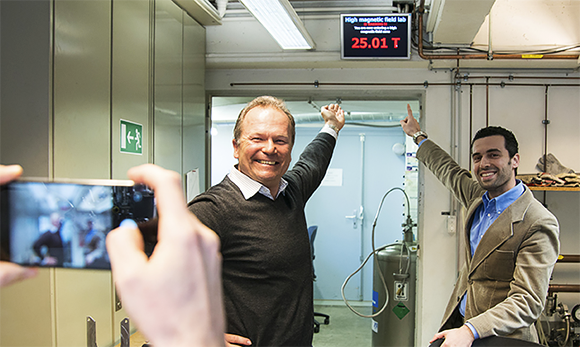![]() New milestone for High Temperature Superconductors at UNIGE
New milestone for High Temperature Superconductors at UNIGE
by Carmine Senatore & Panos Charitos

Details of the innovative superconducting coil, conceived and manufactured by researchers from UNIGE and Bruker BioSpin. (Image: © L. Windels, UNIGE)
High field superconducting magnets are the enabling technology for particle colliders, modern magnetic medical imaging, magnetic resonance spectroscopy and fusion reactors. To further push the boundaries of science, enhancing resolution or energy, these devices call for ever increasing magnetic fields. However, solenoidal coils built with the Low Temperature Superconductors (LTS) NbTi and Nb3Sn are limited to around 23.5 T while accelerator dipole magnets based on LTS will most likely reach their ultimate performance at about 16 T.
Recent progresses in the technology of High Temperature Superconductors (HTS) and, in particular, in REBa2Cu3O7-x (REBCO, RE = rare earth) coated conductors (CCs) have paved a way for the development of all-superconducting solenoids capable of generating fields in the range of 30 T, i.e. well beyond the limits of the present technology. However, the development of REBCO magnets still poses several fundamental and engineering challenges.
Carmine Senatore, Professor at the University of Geneva (UNIGE) is actively working in the study of applied superconductivity and through EuroCirCol is working for the development of high-field magnets for a future circular collider based on Nb3Sn under the scope of the FCC Study and EuroCirCol project. Senarore, also works on the development of HTS magnets. He is deputy leader of one of the working packages of EuCARD2 (WP 10.2) exploring different HTS conductor concepts and aiming to manufacture conductor prototypes to feed the HTS accelerator magnet demonstration program, which is the scope of WP10.
Recently his research group in the University of Geneva achieved the goal of generating a magnetic field of 25 T and, thus, obtaining the European record of highest superconducting generated magnetic field. Researchers at UNIGE worked closely with Bruker BioSpin to combine a Bruker laboratory magnet producing 21 T, already installed at UNIGE, with an innovative superconducting insert coil that allowed to increase the field by an additional 4 T. This means that in total, a field well beyond the 23.5 T reachable with conventional superconducting coils could be generated.

Piotr Komorowski, R&D engineer at Bruker and Professor Carmine Senator (UNIGE) pointing to the record field of 25T (Credits: UNIGE)
Concerning the scope of the project, Senatore says: «high magnetic fields are an indispensable tool for research in physics and material science as well as medical applications. This technological need represents the driver for the development of HTS, as they are the only means to generate fields well above 20 T». Riccardo Tediosi, manager of Bruker BioSpin’s Superconducting Technologies group adds: "the successful test of the 25 T coil represents a positive test-bench of ideas that we are developing for the next-generation HTS-based NMR magnets. We see that commercial breakthroughs in this field are at reach and 2017-2018 is going to be a very exciting period for Bruker and the NMR community."
The REBCO tapes used to achieve the 25 T in the solenoidal magnet are also studied under EuCARD-2 to build a dipole demonstrator able to generate 5 T in standalone configuration. It is then planned to use the same dipole demonstrator in a background field allowing to reach fields of up to 20 T. The 20 T target in the dipole compared to the 25 T reached in the solenoid should not generate confusion. Compared to solenoids, accelerator magnets are different “animals”: they need compact windings for reason of efficiency and cost, very high currents to ease protection, and they experience large forces transverse to the cable. Simple electromagnetics tells us, they require the double of ampere-turns to generate the same field.
However, there is much in common between the 25 T development based on REBCO coils and the goals of EuCARD-2. Senatore explains: We investigated the electrical, mechanical and thermo-physical properties of commercial REBCO tapes from all over the world. The results of these studies guided the choice of the commercial tape to be used for our insert coil and at the same time provided important inputs to the development of the conductor for the dipole prototype of EuCARD-2. The EuCARD-2 dipole will use these tapes in the form of a Roebel cable, a century old technology used for electrical machines. First winding tests have been performed, in various geometries, and a small coil is presently in test at CERN to validate the manufacturing process that will be used for the final magnet, planned for 2017.
